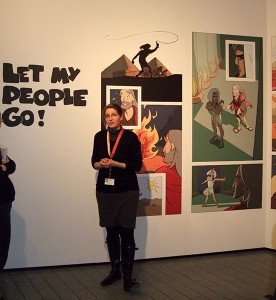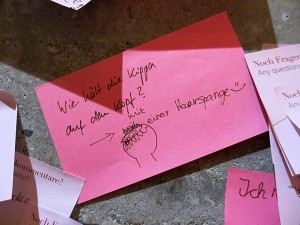This year, the national museum assistant convention of the German Museums Association took place from March 1 to 3 in Frankfurt-am-Main, and the theme was “Museum today: ideals, trends, and perspectives.” The convention offered academic trainees from federal German museums and memorials an extensive array of lectures, excursions, and workshops. Along with all the other museum assistants, I was impressed by the diversity of events. The Historical Museum served as a set starting point, having put nearly its entire premises at the disposal of the convention.

Sabine Kößling in front of the remodeled mural at the Jewish Museum Frankfurt
© photo: Michaela Roßberg, Jewish Museum Berlin
On the day of our arrival, there was already a chance to take a tour through one of the many museums on the embankment of the Main. I visited the Jewish Museum Frankfurt, where our group was guided by Sabine Kößling, a former museum assistant at the Jewish Museum Berlin. She told us about the planned conception of the permanent exhibition, which originates largely from 1988, the year that the museum was founded. The reworking of the exhibition is being done in stages, so that the entire museum won’t need to be closed to visitors until 2014. The section on “Festivals and feast days – religious life”, for example, was being augmented with a large mural depicting the story of Moses and the Pharaoh.
The second day featured a number of workshops. I participated first in one called “Provenance research is power: arm yourself.” → continue reading
With a flip of a wrist, showcases turn arbitrary objects into works of art. Now, I can find out what it will do to a human being. I am sitting in a transparent case which is part of the current special exhibition “The Whole Truth… everything you always wanted to know about Jews.” The visitors pass by, and we observe each other. Many read the text on the wall, throw me a look and hurry away.

Olga Mannheimer as a guest in the “Whole Truth” exhibition
© photo: Ernst Fesseler, Jewish Museum Berlin
Some stop, but keep a safe distance. I clear my throat, smile invitingly, and motion to the button on my blouse: “Ask me, I’m Jewish.” I qualified for this position, as I learned from a speech at the opening of the exhibition, by claiming to be able to tell the “whole truth” about Jews. Will anyone ask me to? The distance gradually shortens. One man wants to know what the object label on the case-window says – he does not have his reading-glasses with him. “Species: Diaspora Jew, Sub-species: Eastern European Jew, Variant: Banana Jew.” Thank you, says the man, and leaves quickly. “Banana Jew? Never heard of it,” says a woman. That was the term for Jews in Poland, I explain, who received citrus fruits and bananas from their relatives in the West.
Hesitantly, more people join the bystanders in front of my showcase. “Are you allowed to bring flowers to a seder?” “Can you sew a foreskin back on?” → continue reading
“How does a kippah stay on?”
Our current special exhibition “The Whole Truth… everything you always wanted to know about Jews” is based on 30 questions posed to the Jewish Museum Berlin or its staff over the past few years. In the exhibition, visitors have their own opportunity to ask questions or to leave comments on post-it notes. Some of these questions will be answered here in our blog. This month’s question is: “How does a kippah stay on?”

“How does a kippah stay on?”
© photo: Anina Falasca, Jewish Museum Berlin
If a non-Jew tries on a kippah, it usually falls off. This isn’t fair, but let’s examine the circumstances more closely. When tourists visit the Jewish cemetery in Prague, all men are asked to wear a kippah. Those who travel kippah-free are requested to don a blue, sharply-creased, circular piece of paper. The precarious kippah is inevitably subjected to the winds off the Vltava and flutters away. Comparably, a non-Jewish man attending a synagogue ceremony such as a marriage or Bar Mitzvah, will usually be requested to wear a kippah. Here, a stiff yet slippery synthetic satin kippah is ubiquitous. No guest stands a chance.
What then is the secret to making a kippah stay on? → continue reading


